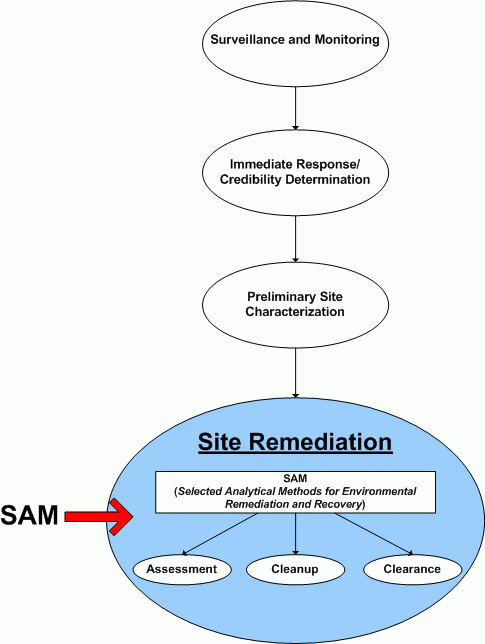Basic Information for EPA's Selected Analytical Methods for Environmental Remediation and Recovery (SAM)
Federal and state personnel often provide response, recovery and remediation support under trying circumstances, including unprecedented demand on laboratory capabilities to analyze environmental and building material samples following intentional or unintentional contamination events. EPA has identified several areas to enhance the resiliency of the nation following such events. The need to improve the nation's laboratory capacity and capability to analyze environmental and building material samples following chemical, biological and/or radiological [CBR] contamination was one of the most important areas identified.
To address this need, EPA formed the Homeland Security Laboratory Capacity Work Group to identify and implement opportunities for near-term improvements and to develop recommendations for addressing longer-term laboratory issues. A critical area identified by the work group was the need for a list of selected analytical methods for use by all laboratories when analyzing contamination event samples and, in particular, when analysis of many samples is required over a short period of time. Using the same selected methods reduces confusion, permits sharing of sample load between laboratories, improves data comparability, and simplifies outsourcing analytical support to the commercial laboratory sector. Use of such methods also improves the follow-up activities of validating results, evaluating data and making decisions. To this end, workgroup members formed an Analytical Methods Subteam, which recognized that widely different analytical methods are required for various phases of sample analyses in support of preparation and response to contamination incidents:
(1) ongoing surveillance and monitoring;
(2) response and rapid screening for determining whether an incident has occurred;
(3) preliminary site characterizations to determine the extent and type of contamination; and
(4) confirmatory laboratory analyses to plan, implement and evaluate the effectiveness of site remediation.
Figure 1-1 represents these analytical phases. EPA's Selected Analytical Methods for Environmental Remediation and Recovery (SAM) provides information for analytical methods to be applied during the "Site Remediation" phase. Methods are selected to support activities related to site assessment (including preliminary, qualitative analyses to characterize the extent of contamination), site cleanup (to evaluate the efficacy of remediation efforts), and site clearance (releasing a site, including water and wastewater systems, for its intended use) decisions.
Figure 1-1. Environmental Evaluation Analytical Process Roadmap for Homeland Security Events

